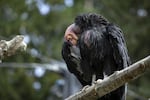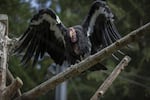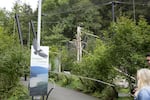Most people probably aren’t thinking about vultures.
“We don’t notice they’re there, but we would notice if they weren’t,” said Travis Koons, animal curator at the Oregon Zoo.
Known for their scavenging tendencies and bald, fleshy heads, vulture species such as California condors are much more than ugly birds, Koons said.
Vultures are like the friend who finishes off that last bit of food you’re too full to eat. They’re akin to street-sweepers, cleaning up remnant animal carcasses that others leave behind. Without them, there would be higher rates of disease, bugs and other undesirables, according to Koons.

California condors have bald, fleshy heads to stay clean when they eat – usually a dead animal carcass.
Miranda Daviduk / OPB
California condors have made a remarkable comeback from the brink of extinction, thanks in part to efforts at the Oregon Zoo. But recently proposed changes to the Endangered Species Act (ESA) could have dire consequences for nature’s master recyclers.
Originally created to protect threatened and endangered plants, animals and their habitats, the ESA has been recognized as the nation’s strongest conservation law. In July, the Trump administration proposed changes to the ESA that would make it harder to protect new species and easier to remove protections — or delist — species that are currently protected, like condors.
Related: Lawmakers Set Sights On Changes To Endangered Species Act
“One thing we heard over and over again was that ESA implementation was not consistent and often times very confusing to navigate,” said U.S. Fish and Wildlife Service Principal Deputy Director Greg Sheehan. “We are proposing these improvements to produce the best conservation results for the species while reducing the regulatory burden on the American people.”
Proposed changes would allow potential economic consequences into the equation when determining protections for plants and animals. Currently, the decision is based solely on scientific research. Threatened species would no longer be automatically granted the same protections as endangered species and critical habitats could shrink, among other things.
“The proposed changes would reduce regulatory protections and our influence over endangered species management,” said Dr. Donald Moore, director of the Oregon Zoo. “It might significantly decrease the condor’s survival as a species.”
The California condors' range once extended from British Columbia, all along the Pacific Coast and down to Baja California.
According to U.S. Fish and Wildlife records, only 23 condors remained in the world by 1982. By 1987, all remaining wild condors were placed in a captive breeding program as a last-ditch recovery effort.

The Oregon Zoo is home to one-tenth of the world's population of California condors. This one is named Kaweah.
Miranda Daviduk / OPB
It worked.
The first birds were reintroduced into the wild in 1992. As of 2017, global California condor counts were up to more than 460 birds, both wild and captive. That was a 6.4 percent increase from 2016.
The Oregon Zoo boasts the second-largest condor program in the country, housing one-tenth of the world’s California condor population, according to Moore.
He credits the species’ recovery to protections from ESA.

The entrance to the condor exhibit at the Oregon Zoo. The zoo has 38 condors – three on exhibit and the remainder in the Jonsson Center for Wildlife Conservation in Clackamas County.
Miranda Daviduk / OPB
“We’ve been working really hard on producing condors and reintroducing them,” Moore said. “Any proposed changes that would weaken the act would weaken our ability to keep animals from going extinct.”
One big threat to condor recovery: lead poisoning. When the current head of the Interior Department, Ryan Zinke, took office, one of his first acts in office was to rescind an Obama administration regulation that banned lead ammunition.
Lead has been the greatest cause of wild population mortality, resulting in approximately 50 percent of known causes of death since 1992, according to a USFWS report. To remedy this, educational programs such as the Hunting With Non-Lead initiative have been created to educate the public, particularly hunters, on the lethal effects on wildlife from lead ammunition.
“Lead exposure has been identified as the leading cause in mortality in free-flying juvenile and adult condors,” said Leland Brown the non-lead hunting education coordinator for the Oregon Zoo. “It’s not visible to hunters — so they’re unaware that it’s happening.”
When a lead bullet enters an animal, toxic fragments spread through the wound channel — leaving fragments of lead in the carcass. Scavengers ingest lead when feasting on the animal remnants leading to lead poisoning.
Although polls show that 90 percent of Americans support the Endangered Species Act, its efficacy is debated. According to the Center for Biological Diversity, between 1973 to 2013, the act prevented extinction for 99 percent of species under its protection. But critics argue inefficiency, saying only one percent of species protected by the ESA have recovered enough for delisting.
California condors were one of the very first animals listed under the ESA.

A ballistics gel shows toxic fragments from a lead bullet. Lead poisoning is the leading cause of condor mortality. The Oregon Zoo participates in a non-lead hunting initiative to inform hunters of the dangers of lead ammunition and provide information on alternatives, like copper.
Miranda Daviduk / OPB
“Condors are one of the most successful species of that program and it’s a direct result of that attention and awareness,” Koons said. “It’s pretty critical that we reverse this way we’re headed.”
Since 2004, 51 condors have been reared at the Oregon Zoo and released into the wild, according to Koons. Six more will be released Sept. 22 in Arizona. But without ESA protections and funding, condors would likely cease to exist. “They’d be a doomed species,” Koons said.
Koons’ goal is to see condors flying over Oregon skies within the next five to ten years.
“In my lifetime, I want to go all the way up to Astoria and see condors flying where they used to be.”
Public comments on the proposed changes to the ESA are accepted until Sept. 24.

